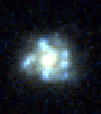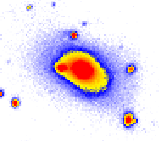PREVIOUS RESEARCH PROJECTS
This page contains a description of some of the previous research programmes which I have undertaken. A selection of older images used in two Astronomy Magazine articles are shown here. Any recent press release information will be found here. This page also includes links to a few other pictures I've made along the way. A few useful rules for operating in this field are given on this page.
SCUBA and Star-formation in Distant Galaxies
Lensing and the Nature of Distant Galaxies
In addition to the HST observations, this sample was also observed in the X-ray with XMM and imaged in the optical over 0.5 degree fields with the CFH12k camera on CFHT. We also obtained spectroscopic observations of the brighter lensed features and the cluster galaxies. These can be used to compare and contrast the properties of these clusters and their galaxy populations with those of the substantially lower-richness clusters also being studied with HST (see here).
The Evolution of Galaxies as a Function of Environment
The second aspect of this program is a similarly detailed study of galaxies in low-density environments at z~0.2 using X-ray selected poor clusters and groups. The core science is based on a sample of nine clusters for which deep imaging with HST obtained during Cycle 8. This compliments the second phase of the MORPHS project which is also using HST to look at the properties of galaxies in the low-density outskirts of very rich clusters. We hope to use the variation of galaxy properties, both star-forming and passive, between the low-density groups and the higher-density clusters to search for the physical mechanisms responsible for the rapid evolution of the galaxy populations within clusters. An extension of this project to a sample at z=0.5 is underway.
MORPHS
 This project aimed at understanding
the evolution of galaxies in high density environments (rich clusters)
over the last 5-8 Gyrs. We combine deep Hubble Space Telescope WFPC2 pointings
of the clusters to determine galaxy morphology with multi-object
spectroscopy of the same galaxies taken with the 5.1-m Hale, 4.2-m WHT,
3.9-m AAT and 3.6-m NTT telescopes. A spectroscopic catalog of
roughly 700 galaxies in the 10 clusters is also available. The
project has now moved to its second phase where we are extending our
study into the outskirts of the clusters to tie the evolution in the
cluster and field populations together. We are also using narrow-band
imaging to investigate the distribution of emission-line galaxies
within the clusters, medium resolution spectroscopy of the
early-type galaxies to search for traces of past star-formation and deep
radio maps to uncover evidence for dusty starburst galaxies. The main
collaborators involved in this work are: Warrick
Couch, Alan
Dressler, Richard
Ellis, Gus
Oemler, Bianca Poggianti and myself. The complete catalogs of objects detected in
our WFPC2 images, as well as information on the morphologies of a
brighter subset are available from here,
while the spectral catalog for these clusters is on this page Images of a few of the clusters are shown
here. A number of the
papers produced by this group are already published.
This project aimed at understanding
the evolution of galaxies in high density environments (rich clusters)
over the last 5-8 Gyrs. We combine deep Hubble Space Telescope WFPC2 pointings
of the clusters to determine galaxy morphology with multi-object
spectroscopy of the same galaxies taken with the 5.1-m Hale, 4.2-m WHT,
3.9-m AAT and 3.6-m NTT telescopes. A spectroscopic catalog of
roughly 700 galaxies in the 10 clusters is also available. The
project has now moved to its second phase where we are extending our
study into the outskirts of the clusters to tie the evolution in the
cluster and field populations together. We are also using narrow-band
imaging to investigate the distribution of emission-line galaxies
within the clusters, medium resolution spectroscopy of the
early-type galaxies to search for traces of past star-formation and deep
radio maps to uncover evidence for dusty starburst galaxies. The main
collaborators involved in this work are: Warrick
Couch, Alan
Dressler, Richard
Ellis, Gus
Oemler, Bianca Poggianti and myself. The complete catalogs of objects detected in
our WFPC2 images, as well as information on the morphologies of a
brighter subset are available from here,
while the spectral catalog for these clusters is on this page Images of a few of the clusters are shown
here. A number of the
papers produced by this group are already published.
CIRCuS and the LCO/2dF Rich Cluster Study
 Moving to even lower redshifts,
this was a long term project to study a statistically reliable sample of
the richest clusters in the southern hemisphere in a redshift slice
between z=0.07-0.15. The project included wide-field
(2×2 degree) B and R imaging from the 40" telescope at Las Campanas Observatory
(Chile) of over 20 clusters, totalling over 70 square degrees of sky.
These images were used to select galaxies for subsequent
spectroscopic follow-up with the 400-fibre 2dF multi-object spectrograph on
the 3.9m AAT in Australia. The aim was to obtain spectra for
significant samples of galaxies
in a subset of the clusters to provide an unprecedented view of
the dynamics of rich clusters and their galaxy populations (see here). The
collaborators in this program are Warrick
Couch, Alastair Edge, Eileen O'Hely,
Kevin Pimbblet,
Ann Zabludoff and me. A true color image of the central regions of
one of our clusters is shown here.
Moving to even lower redshifts,
this was a long term project to study a statistically reliable sample of
the richest clusters in the southern hemisphere in a redshift slice
between z=0.07-0.15. The project included wide-field
(2×2 degree) B and R imaging from the 40" telescope at Las Campanas Observatory
(Chile) of over 20 clusters, totalling over 70 square degrees of sky.
These images were used to select galaxies for subsequent
spectroscopic follow-up with the 400-fibre 2dF multi-object spectrograph on
the 3.9m AAT in Australia. The aim was to obtain spectra for
significant samples of galaxies
in a subset of the clusters to provide an unprecedented view of
the dynamics of rich clusters and their galaxy populations (see here). The
collaborators in this program are Warrick
Couch, Alastair Edge, Eileen O'Hely,
Kevin Pimbblet,
Ann Zabludoff and me. A true color image of the central regions of
one of our clusters is shown here.
Bits-n-Bobs
A few spin-off projects (some using data taken for other purposes by other people and some using data taken by other people for the same purpose). To save trees my to-do list is here.``A Catalogue of Morphologies for Dwarf Galaxies in the Coma Cluster'', Smail, I., Lucey, J.R., Davies, R.L., de Jong, R., Smith, R.J., 20xx, in imagination.
And I hope you've noticed that I'm quite definitely not doing anything on intra-cluster light... although I can advise on this topic.